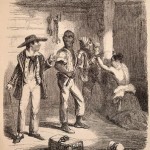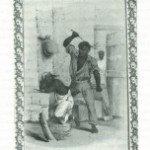McInnis, Maurie D. Slaves Waiting for Sale: Abolitionist Art and the American Slave Trade. University of Chicago Press, 2011

Slaves Waiting for Sale, by Eyre Crowe
This is an excellent work as a reference from the Virigina slave trade in the 1850s. The author includes all kinds of “you are there” details, including clothing and architecture.
Built around work of British artist and journalist Eyre Crowe, who travelled in America in the 1850s as secretary to author William Thackery on a lecture tour.
Crowe read Uncle Tom’s Cabin before he saw any actual slavery, but was moved by it. (Pg.4) Purchased from street book merchant, also selling Thackery’s books. Crowe was “properly harrowed” by the book. (Pg. 19)
Crowe discretely visited a slave auction in Richmond, Virginia. “No pen, we think, can adequately delineate the choking sense of horror which overcomes one on first witnessing these degrading spectacles.” Crowe’s images sketched are not shocking or horrific. Conform to standard codes of depicting slavery. Imagery that was too shocking would not have been accepted for mainstream publication and exhibition. He had to depict it within the constraints of high art. (Pg. 25)
There was a female version of the Wedgewood medallion that showed “a kneeling woman, nude to the waist, hands shackled and clasped, asking ‘Am I Not a Woman and a Sister?’” (Pg. 32)
The image of the chained and enslaved woman carried contradictory messages. While pleading for consideration based on Christian values, the figure’s physical vulnerability also communicated an eroticism that had long been an important tenet of slavery imagery. […] By the Victorian period, such overtly sexual depictions had softened, but many images still contained elements of eroticism. George Cruikshank’s Slavery in the West Indies (fig. 2.2) employs a version of the female supplicant slave, but in this image there is little ambiguity. The enslaved woman will not be saved by an English female antislavery activist; instead, she kneels at the mercy of her overseer, whose possible intentions, with his legs spread and his phallic whip raised over his head, seem only too clear.
Women antislavery activists brought a moral and Christian emphasis to their work, and the materials and visual images produced for and by them differed considerably from earlier ones. The supplicant, kneeling, female slave became a dominant visual motif, but it was infused with Christian messages. [pg.33]
Both Northerners and Southerners reviled slave traders. (pg. 90)
A commonly expressed sentiment, published in Daniel Hundley’s proslavery book Social Relations in Our Southern States (1860), described [slave] traders not as true Southerners but as Yankees because of their “grasping” instincts, “villainy,” and “greedy love of filthy lucre.” [Pg. 90]
The illustration to Solomon Northrup’s slave narrative Twelve Years a Slave embellishes the description of Northrup’s cell:
Even though the masonry in that cell was most likely brick, the artist transformed it into stone, creating imagery that, combined with a huge iron door, an iron lock, and a set of heavy chains, made it look very much like a dungeon. […]
Any slave looking at this image would know that it was not drawn from the facts of the event. The whip, for example, was the kind commonly employed in abolitionist imagery, but not the kind commonly employed by traders. Abolitionist Fredrika Bremer was informed by a jailer in Richmond that they usually used an instrument they called the “paddle,” which did not leave a mark on the skin. […]
The Image in Northrup’s book also relied heavily on the iconographic tradition of the supplicant slave. By showing Northrup on his hands and knees, his wrists bound with shackles, and the trader standing over him with a whipe, the image suggests that the entreaties of the supplicant slave have gone unheard and that the system of slavery is so heinous that it could break even a free man. [Pg.110]
A young man from New York was also present at the same slave auction as Eyre Crowe, and observed him being kicked out. His own account viewed the event through the archetypes of Uncle Tom’s Cabin. “I saw ‘Cassie’s’ character in this woman fully and fairly sticking out.” and “I tell you for a truth that I saw full one hundred [Simon] Legrees, and even worse than he.” (Pg. 117)
“Fancy girls” were usually young and attractive mulatto women, who often brought more money at auction than the most skilled male slaves. When visiting Richmond, Swiss traveler Fredrika Bremer visited a slave jail where, she said, they kept “the so-called ‘fancy girls’ for fancy purchasers. They were handsome fair mulattoes, some of them almost white girls.” […] Numerous letters and textual references make clear that many of these women were purchased for sexual exploitation. Slave dealers took care to pint out the gradations in skin tone, and light-skinned women such as “the fair maid Martha” and “white Caroline” were highly valued in the market place, especially in Natchez and New Orleans. Although it was largely unspoken, everyone understood their likely ultimate fate.
Some were willing to be explicit about the practice of purchasing fancy women. Sarah Parker Redmond, a free African American woman who traveled in Britain as an antislavery lecturer, told her audiences that women were “sold into slavery with cheeks like the lily and the rose, as well as those that might compare with the wing of the raven.” When slave women were for sale at auction, the more “Anglo-Saxon blood” they possessed, the “more gold [was] poured out,” because, Redmond explained, “they are sold to be concubines for white Americans. They are not sold for plantation slaves.” [Pg.139]
Lefevre James Cranstone’s Slave Auction, Virginia (painting, 1861) focused on “yellow beauties” who were “bright-eyed, smooth of skin, supple of form, full-chested, clean-limbed creatures” (his description). Close examination shows men fondling a slave woman’s breast under cover of touching her neck ribbon. (Pg.140-141)
The anonymous painting Slave Market (pg.142) has as centrepiece a light-skinned woman dressed as an elite young woman would be.
Another illustration of Northrup’s book shows the author’s hint that Eliza’s daughter would be sold as a fancy girl by depicting the girl as white, in contract to her mother. (Pg.164)
In a parade to celebrate their freedom, the newly freed slaves of Charleston mockingly reenacted the most hated aspect of enslavement. According to a New York Times account, a long procession of marshals, members of the U.S. colored troops, butchers, school children, tailors, fireman, and representatives of other trades was followed by a cart portraying an auctioneer selling two women and their children from an auction block. The cart carried a banner reading “A number of negroes for sale,” and as it moved through the crowd, according to the reporter, “the auctioneer would appeal to the crowd for a bid, making use of the phrases… usually heard in a negro auction room.” The auctioneer would call out that one was an excellent cook, another an expert seamstress, and then run up the price “to an extravagant amount – in Confederate money, of course.” The full meaning of this cart was completed by the one that rolled behind; it was a hearse “bearing a coffin, and having the inscription: ‘Slavery is dead’; ‘Who owns him?’ ‘No one’; ‘Sumter dug his grave on the 13th of April, 1861.’” [Pg.215-216]
Cf. the ritual re-enactments of Barbary Coast captivity by former prisoners on their return to Europe.



